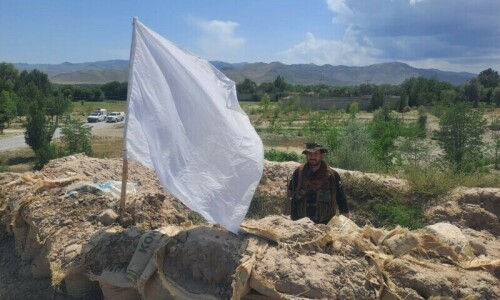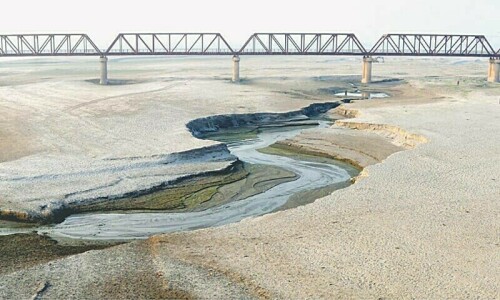Swarming throngs of devotees bathed in rivers at India’s Maha Kumbh Mela festival on Thursday, undeterred by a stampede a day earlier that killed at least 30 people.
The Kumbh Mela attracts tens of millions of Hindu faithful from around India every 12 years to the northern city of Prayagraj, but has a woeful record of deadly crowd incidents.
Yesterday’s pre-dawn disaster, which saw a surging crowd spill out of a police cordon and trample bystanders, prompted some spooked pilgrims to leave the festival. Police said 30 people were killed in the crush and 90 were injured, but sources told Reuters the death toll was nearly 40.
But many more were still arriving in the stampede’s aftermath to participate in what they said was a matter of religious obligation.
“We’ve obviously heard about the stampede,” 21-year-old Naveen Pradhan, who arrived at the festival with his family hours after the disaster, told AFP.
“But this is a holy thing, a religious thing, something we should do as Hindus, and my family wouldn’t have missed this no matter what.”
The six-week Kumbh Mela is the single biggest milestone on the Hindu religious calendar, and Wednesday marked one of the holiest days in the festival, coinciding with an alignment of the Solar System’s planets.
Despite the early morning disaster, saffron-clad holy men continued with the day’s rituals hours later, leading millions into a sin-cleansing bath by the confluence of the Ganges and Yamuna rivers.
“The journey was challenging — the trains were packed, the train stations were packed,” pharmacist Padmabati Dam, who travelled by train for more than 1,000 kilometres to reach the festival, told AFP.
“We were tired after such a long journey but as soon as we took a dip in the river we just felt so fresh and happy. It was as if all that inconvenience was really worth it.”
Probe ordered
Indian authorities have ordered a probe into the stampede. Police said 30 people were killed in the crush at the world’s biggest gathering of humanity and 90 were injured, but sources told Reuters the death toll was nearly 40.
Some witnesses spoke of a huge push towards the rivers that caused devotees to fall on each other, while others said closure of routes to the water brought the dense crowd to a standstill and caused people to collapse due to suffocation.
“The government has decided that a judicial inquiry of the incident will be done. For this, we have formed a three-member judicial commission,” Uttar Pradesh state Chief Minister Yogi Adityanath told reporters late on Wednesday.
“The judicial commission will look into the entire matter and submit its report to the state government within a time limit,” he said.
More than 76 million people took a dip at the confluence of three sacred rivers in Prayagraj in the northern state of Uttar Pradesh until 8pm (7:30pm PKT) on Wednesday alone, officials said.
Opposition leaders have blamed the stampede on mismanagement and urged the government to improve festival arrangements, while local media said on Thursday that better crowd planning was needed to prevent such incidents.
“There is much scope for improving crowd management at the Kumbh,” the Hindustan Times newspaper said in an editorial.
“There is no doubt that more personnel have to be deployed, and better planning is needed - using both ground resources and modern technology,” it said, adding that a repeat of the tragedy must be prevented at the three “royal dips” scheduled in coming weeks.
Mythological battle
The Kumbh Mela is rooted in a mythological Hindu battle between deities and demons for control of a pitcher containing the nectar of immortality.
Devout Hindus believe that taking a dip at the confluence of three sacred rivers — the Ganga, Yamuna, and mythical Saraswati — absolves them of sins and brings salvation from the cycle of birth and death.

Organisers have likened the scale of this year’s festival to a temporary country, forecasting up to 400 million pilgrims would visit before the final day on February 26.
Authorities waited nearly 18 hours after yesterday’s stampede to give an official death toll, an apparent effort to minimise disruption to the day’s events.
Even before the latest incident, attendees have fumed over what they said was poor crowd management.
Reserved pathways and cordoned-off areas reserved for eminent attendees have been a source of vehement complaints at the festival for reducing the amount of space for common pilgrims.
Police this year installed hundreds of cameras at the festival site and on roads leading to the sprawling encampment, mounted on poles and a fleet of overhead drones.
The surveillance network feeds into an artificial intelligence system at a command and control centre meant to alert staff if sections of the crowd get so concentrated that they pose a safety threat.
More than 400 people died after they were trampled or drowned at the Kumbh Mela on a single day of the festival in 1954, one of the largest tolls in a crowd-related disaster globally.
Another 36 people were crushed to death in 2013, the last time the festival was staged in Prayagraj.














































Dear visitor, the comments section is undergoing an overhaul and will return soon.